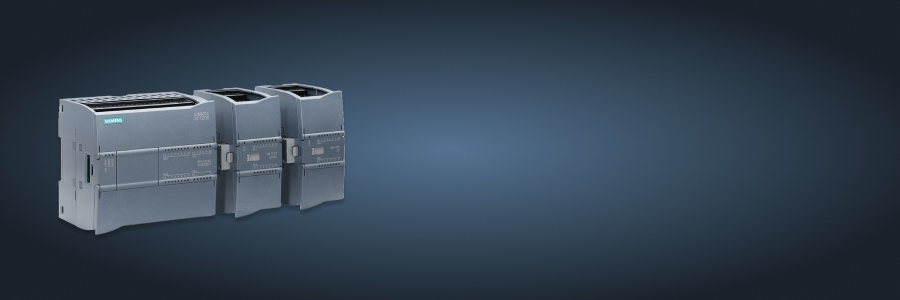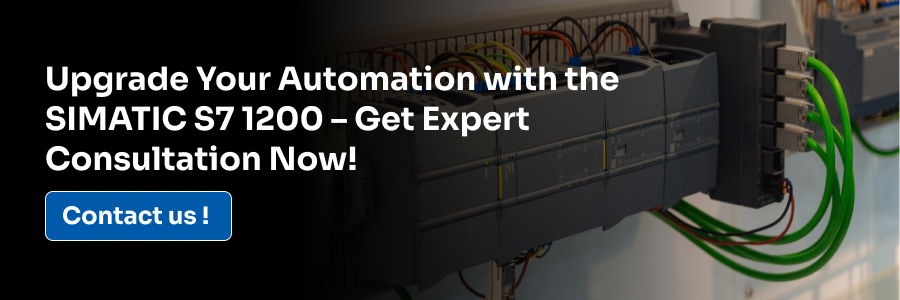The SIMATIC S7 1200 is a compact PLC with advanced communication and complete integration in the Siemens Totally Integrated Automation (TIA) environment. The top 10 features that make it a must-have in modern industries are discussed in this article.
1. Compact and Space-Saving Design
The SIMATIC S7 1200 is built for efficiency. Especially industrial spaces with small machinery and modular production systems have little room for large controllers. With its small footprint and modular expandability, the S7 1200 PLC solves this problem for tight installation spaces.
- Integrated Design: The CPU, power supply and input/output modules are all housed in one compact unit. This allows easy installation/maintenance.
- Stackable Modules: The S7-1200 can be expanded easily by stacking on top of existing modules without taking up much space, adding additional I / O connections, and communication options. specialty modules as needed.
- Rugged Construction: Designed for harsh industrial conditions such as vibrations, temperature changes and humidity, it provides robust performance in food processing and automotive manufacturing.
2. Integrated Communication Functions
In Modern industrial processes, machine-to-machine (M2M) communication is required for synchronized operations and data exchange. The SIMATIC S7 1200 excels here with its built-in communications for enhanced system connectivity and integration.
- PROFINET Interface: The PLC incorporates a PROFINET interface for networking with HMIs (Human-Machine Interfaces), distributed I/Os, and other controllers. This simplifies communications among different automation devices.
- Ethernet-Based Communication: Fast and secure data exchange via Ethernet allows real-time monitoring and control via SCADA systems or cloud-based industrial platforms.
- Flexible Networking: PLC supports standard industrial protocols like Modbus TCP, OPC UA and PROFIBUS for integration with legacy and modern automation systems.
Also, visit Why Siemens PLC S7-1200 is the best choice for Compact Automation System
3. Comprehensive Technology Functions
The SIMATIC S7 1200 PLC is designed to perform complex automation tasks without the need for additional hardware. Siemens incorporated robust motion control, logic processing and analogue handling features for demanding industries.
- Motion Control Capabilities: The S7-1200 incorporates high-speed counters and pulse train outputs for precise motion control applications such as robotics, CNC machining and conveyor belt automation with stepper motors, and servo drives for high-precision control of packaging, and assembly lines.
- PID Control Functions: It has built-in PID (Proportional-Integral-Derivative) controllers for temperature, pressure and speed regulation—useful to HVAC, water treatment plant and chemical process industries.
- Efficient Data Handling & Storage. The S7-1200 can log data and handle recipes so process parameters and historical data can be stored and analyzed later. This is useful for industries doing batch processing like pharmaceuticals and foods.
4. Flexible Configuration Options
One of the key features of the SIMATIC S7 1200 is the modular Configuration allowing businesses to build their automation setup to meet their specific operational requirements.
- Expandable CPU Variants: The S7-1200 series offers different CPU models for different processing power requirements, such as basic CPUs for small-scale automation tasks & advanced CPUs with more memory and extended communication for complex industrial tasks.
- Seamless I/O Expansion: The controller supports digital and analogue expansion modules for industries to scale their sensor and actuator connections easily. Available signal boards and signal modules (SMs) are flexible to process control requirements.
- Multiple Power Supply Options: It works in both AC and DC modes and is therefore flexible for industries to integrate it into diverse electrical environments.
5. Integrated Web Server for Remote Monitoring and Control
With the development of smart automation, real-time monitoring and remote diagnostics have become critical requirements for industries. Siemens has reacted by providing a web server for the SIMATIC S7 1200 that operators can use to access and control their PLC from anywhere using a web browser. Benefits of Integrated Web Server:
Key Benefits of the Integrated Web Server:
- Remote System Access: Operators see real-time data, adjust parameters & perform commands from any connected laptop, tablet or smartphone.
- Secure User Authentication: Multi-level password protection keeps critical changes only for authorized personnel.
- Diagnostic and Troubleshooting Tools: The web server provides live system diagnostics so maintenance teams can identify and resolve issues remotely, reducing downtime and operational disruptions.
- Visualization and Dashboard Integration: Allows the creation of custom dashboards showing live machine data, alarms & historical trends. Very useful for industries requiring 24/7 monitoring like power plants, refineries & automated warehouses.
6. Energy Efficiency Operations
Many industrial automation systems use a lot of energy, which causes high operational costs. With the SIMATIC S7 1200, this issue is addressed intelligently through energy-saving features allowing industries to reduce power consumption without compromising performance. Especially in large-scale manufacturing, food processing and HVAC systems, where even small energy savings can add up to big savings.
- Optimized Power Management: Power consumption is minimal, and power distribution is avoided on the S7-1200.
- Smart Sleep Modes: In the controller, there are standby and sleep functions that stop nonessential operations in idle periods, saving energy consumption.
- Real-Time Energy Monitoring: Integrated into the Siemens Energy Suite, businesses can track power consumption in real-time—find inefficiencies & implement energy-saving strategies.
7. High Processing Speed for Fast Response Times
Automation success depends on how well a system can react to changes in an industrial environment. And no matter what the application—conveyor belt system, packaging line or robotic arm—is, the execution of commands with minimum delay is essential. The SIMATIC S7 1200 offers high processing speeds for industries requiring real-time automation.
- Ultra-Fast Execution: The S7-1200 processes commands in microseconds, avoiding delays and bottlenecks in industrial processes.
- Advanced Data Handling: It performs complex calculations, data logging and real-time analytics, enabling better decision-making and process accuracy.
- Consistent Performance: High-speed logic processing for motion control, sorting & high-speed manufacturing lines.
8. Robust and Durable Construction
The industrial automation environments may be harsh, abusive & demanding. Machines and control units have to endure extreme temperatures, humidity, vibrations and dust within a certain lifetime. It is built tough enough to withstand harsh conditions without requiring frequent maintenance of the SIMATIC S7 1200.
- IP-Rated Protection: IP20-rated housing: protected against dust, moisture, and contaminants; for mining, oil & gas, and outdoor automation.
- Vibration & Shock Resistance: It is built for constant movement and mechanical stress and is used in automated machinery, transport systems and mobile equipment.
9. Advanced Security Features for Cyber Protection
As industrial automation systems become connected and digitized. Factory automation, data breaches & cyberattacks are all threats to factories, smart grids & critical infrastructure. In response to this, the S7 1200 PLC provides strong cybersecurity features for system integrity against external threats in industrial operations.
- User Authentication & Encryption: Supports password-protected access and data encryption so only authorized personnel can make changes.
- Firewall & Access Control: Features integrated security firewalls to prevent unauthorized changes or remote intrusions into the system.
- Secure Remote Access: While the S7-1200 supports remote monitoring, multi-layered security protocols prevent unauthorized remote control.
10. Cost-effective solution for Scalable Automation
Any business aiming to achieve automation with a lower potential for extremely high costs should use the SIMATIC S7 1200. It strikes a balance between performance, flexibility and affordability and is therefore appropriate for startups and SMEs as well as for large-scale enterprises.
- Scalability for Growth: Modular design lets industries begin small and grow their automation needs over time, with less risk of initial investment.
- All-in-One Functionality: While traditional PLCs need many more add-ons, the S7-1200 performs communication, motion control and diagnostics in one hardware unit.
- Long-Term Investment: Supports Industry 4.0/IIoT applications for future compatibility and avoids frequent hardware upgrades.
Final Thoughts: A Versatile and Future-Ready Automation Controller
Unparalleled performance, security, efficiency and economy are the hallmarks of the S7 1200. Do you need high-speed processing, energy efficiency or high cybersecurity? This PLC offers industrial-standard automation. At Naksh Technology Solutions LLP, we offer Siemens automation products like the SIMATIC S7 1200 PLC for industries looking for simple and effective automation.
Get bespoke solutions, expert advice and ongoing support to maximize the return on automation investments for businesses. For custom automation solutions & end-to-end industrial automation support, contact Naksh Technology Solutions LLP—your Siemens automation specialist.
FAQs
Q1. What is the SIMATIC S7-1200 used for?
A. The SIMATIC S7-1200 is a compact, modular PLC designed for small to medium-sized automation tasks, offering flexibility, scalability, and advanced communication capabilities.
Q2. Is the SIMATIC S7-1200 suitable for Industry 4.0 applications?
A. Yes, With built-in Ethernet, cloud connectivity, and cybersecurity features, the S7-1200 is well-suited for smart manufacturing and Industry 4.0 environments.
Q3. What are the different types of S7-1200 CPUs available?
A. Different CPU models vary based on processing power, integrated I/O quantity, and communication options to suit various application needs.

